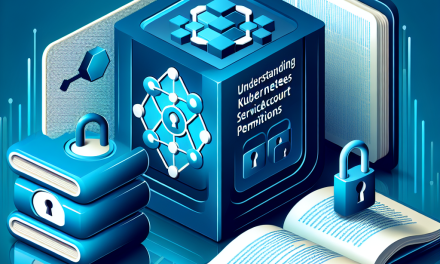As organizations increasingly adopt Kubernetes as their container orchestration platform, the need for securing sensitive data within Kubernetes clusters becomes paramount. Object storage has emerged as a vital component in managing and storing data within microservices architectures. However, the security of this data is only as robust as the encryption methods employed. In this article, we’ll discuss best practices for encrypting Kubernetes object storage, helping you safeguard your data in a cloud-native environment.
1. Understand Encryption Options
Kubernetes offers multiple ways to implement encryption for object storage:
- At-Rest Encryption: Encrypts data when it is stored on disk, ensuring that even if unauthorized access occurs, the data remains unreadable.
- In-Transit Encryption: Protects data as it travels between services, preventing interception and eavesdropping through protocols like TLS.
Familiarize yourself with both options to determine the most suitable encryption strategy for your application’s needs.
2. Enable Encryption for Kubernetes Secrets
Kubernetes allows you to store sensitive information such as passwords or API keys as secrets. However, it’s essential to encrypt these secrets to prevent unauthorized access. Here’s how to do it:
- Use Encryption at Rest: Configure the Kubernetes API server to store secrets in an encrypted format using the
--encryption-provider-configflag. - Choose a Strong Encryption Provider: Select appropriate encryption providers (such as AES or TLS) to ensure robustness. The key management system (KMS) should be secure and regulated.
Example Configuration:
yaml
kind: EncryptionConfig
apiVersion: security.k8s.io/v1
resources:
- resources:
- secrets
providers: - aescbc:
keys:- name: key1
secret:
- name: key1
- identity: {}
- secrets
3. Implement Role-Based Access Control (RBAC)
Even the best encryption methods can be compromised if access isn’t tightly controlled. Implement Role-Based Access Control (RBAC) to ensure that only authorized users and applications can access encrypted object storage.
- Define Roles and RoleBindings: Clearly define roles with minimal permissions and assign them to users or service accounts only as necessary.
- Audit Access Regularly: Conduct regular audits on RBAC configurations to ensure compliance with best security practices.
4. Use Persistent Volumes with Encryption
For applications requiring persistent data storage in Kubernetes, it’s crucial to utilize Persistent Volumes (PVs) with built-in encryption support offered by cloud providers.
- Cloud Storage Configurations: Services such as AWS S3, Google Cloud Storage, and Azure Blob Storage often provide encryption mechanisms to secure stored data. Ensure that these settings are active.
- Data Encryption Keys: Use a key management service (KMS) to manage encryption keys securely. Rotate keys regularly to enhance security.
5. Use External Secrets Management
For applications requiring highly sensitive data such as API keys, leverage external secrets management solutions like HashiCorp Vault or AWS Secrets Manager. These tools offer:
- Fine-Grained Access Control: Determine who has access to what secrets, helping to minimize the risk of exposure.
- Automatic Rotation: Enable automatic rotation of secrets, ensuring that they remain secure over time.
6. Enable Network Policies
Implementing network policies within a Kubernetes cluster can help regulate traffic between pods and services, adding an additional layer of security.
- Restrict Pod Communication: Define rules that restrict traffic between pods, ensuring that only authorized pods can communicate with each other.
- Control Data Flow to Object Storage: Ensure that the access to your object storage is limited to specific methods and services.
7. Regularly Monitor and Audit
Continuous monitoring and auditing are vital for maintaining the integrity of encrypted data in Kubernetes.
- Log Access Events: Use tools like Fluentd or ELK Stack to monitor and log access to object storage services.
- Export Audit Logs: Continuously analyze audit logs to ensure that unauthorized access attempts are identified and addressed promptly.
8. Stay Informed on Security Updates
Cybersecurity is an ever-evolving landscape. Regularly update your Kubernetes cluster and its associated tools to incorporate the latest security patches and enhancements.
- Subscribe to Security Bulletins: Follow relevant Kubernetes and cloud provider security advisories to stay informed.
- Participate in the Community: Engage with the Kubernetes community to learn about best practices and emerging encryption techniques.
Conclusion
Encrypting object storage in Kubernetes is crucial to safeguarding sensitive data. By following these best practices—understanding encryption options, implementing RBAC, utilizing secret management tools, and maintaining vigilant monitoring—you can significantly enhance your security posture in a cloud-native environment. As you adopt these practices, ensure that your team is informed and engaged in proactive security measures to protect your vital data assets.
By prioritizing encryption, you not only comply with regulations but also establish trust with customers who entrust you with their confidential information. Secure your Kubernetes environment today to pave the way for continued innovation and reliability in your applications.





